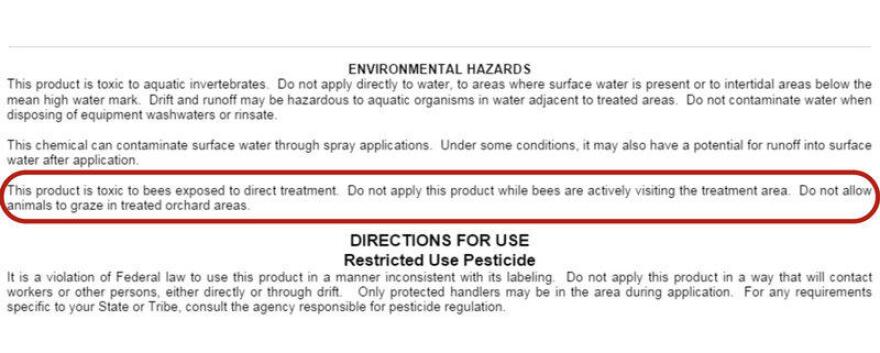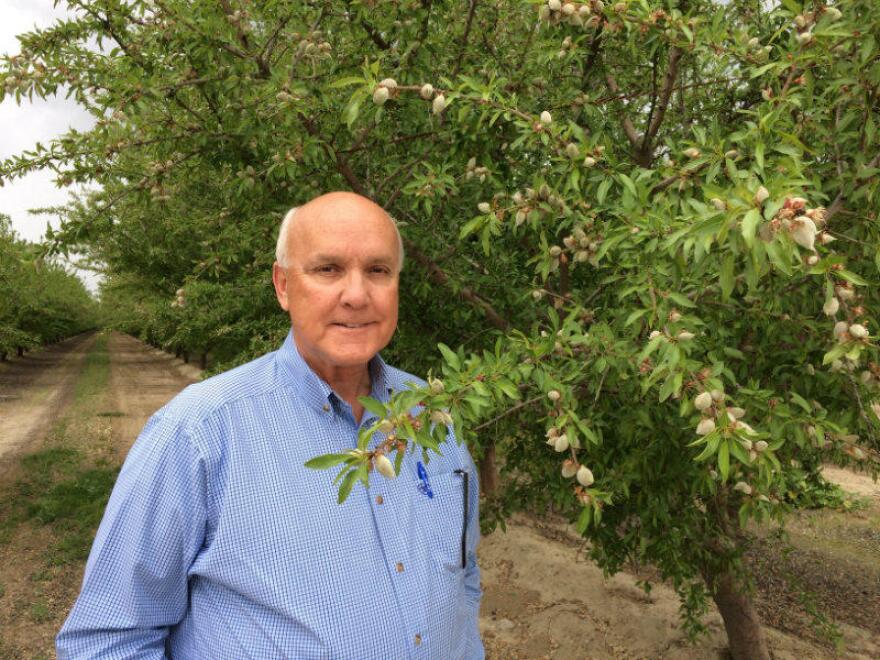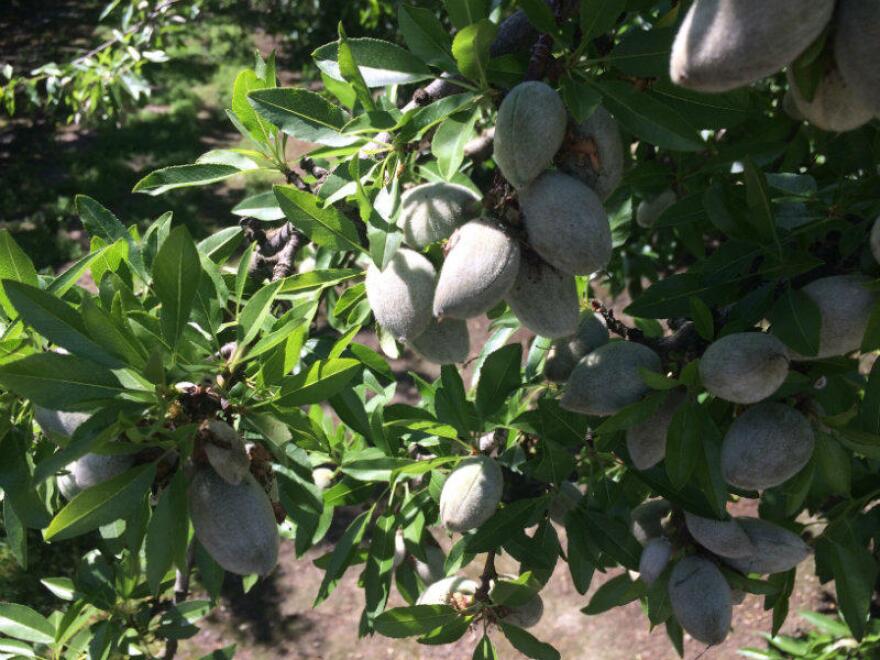The Beekeeper
When Rafael Reynaga came to check on his bee colonies in a Fresno almond orchard, he found a carpet full of dead bees on the ground.
Reynaga picked up a hive and found two inches of bees at the bottom. He says most were dead, but a few were still moving.

Dead bees reek, Reynaga says, like a dead rat.
He's been working with bees since the 1980s but he says he'd never experienced a bee kill firsthand until this February.
He'd lent two hundred hives to his brother, fellow beekeeper Raul Reynaga. The latter had a pollination contract with an almond grower in Reedley on the east side of Fresno.
He suspects his honeybees died from pesticide exposure.
“The bees act in a specific way when they are poisoned,” adds Reynaga. “They fly in circles close to the ground.”

To Reynaga these bee deaths point to a pesticide spray to blooming crops. But he says his hives went in before the almond bloom. The closest blooming crop were nectarines.
Reynaga filed a "Report of Loss” with the Fresno County Agricultural Commissioner’s office. He says it’s a big hit to his business - a $100,000 loss.
Protecting The Bees
Almond pollination is the busiest time of year for California’s commercial beekeepers. They scramble around the state as they move their colonies into orchards just ahead of the bloom.
Gene Brandi is president of the American Beekeeping Federation and a longtime beekeeper from Madera.
Brandi says he works with fifteen different growers across the state during pollination. It’s a logistical feat to move thousands of hives into place just before almond bloom while weather changes hour by hour. Keeping the bees healthy and safe is a huge priority.
During pollination, some beekeepers rely on a notification system to find out about pesticide applications close to their hives.
Here’s how the notification system works in Fresno County. Beekeepers can register the location of hives as they place them for pollination. It’s voluntary. The county pins those locations to a digital bee map.

Growers, or the pesticide applicators they work with, must file a "Notice of Intent" with the Fresno County Agricultural Commissioner if they plan to apply anything toxic to bees according to the label.
The county has 16 hours to check the spray location against the bee map and reply to the grower (or pesticide applicator) with contact details for anyone with registered hives within a one mile radius.
The last step: the grower (or pesticide applicator) is required to message registered beekeepers with a heads-up 48 hours ahead of the spray application.
Some beekeepers choose to register their hives and receive notification, but many do not, according to the Fresno County Agricultural Commissioner's office. They say several beekeepers in the bee kill areas were not registered for February pollination.
Gene Brandi says he registers his hives with the county. It’s a valuable source of information.
But here’s the catch. Brandi says the notification system is not the main safeguard in protecting honeybees from pesticide exposure.
It’s the label.
The Label Is The Law
Just because a beekeeper gets a phone or email notification about a pesticide application does not mean they’ll move their bees out, explains Gene Brandi.
The bees are in the almond orchards to do a job - pollination. “We can’t move them out until it’s done,” says Brandi.
In California, protection for honey bees comes in the form of bee warnings on specific pesticide labels.

The label is the law. That means regardless of where hives are registered, growers (and pesticide applicators on staff) are required to follow the label’s language.
Brandi is confident growers, pesticide applicators, beekeepers and county ag officials all understand following the label to mean: only apply these pesticides at night, when honey bees are not working.
Brandi is counting on the Fresno County Agricultural Commissioner to get to the bottom of what caused the bee kills in February. Regardless of the cause, he says, “This shouldn’t have happened.”
For Brandi, seeing pictures of Reynaga’s dead bees from Reedley brought back unwelcome memories of a bee kill his brother experienced decades ago.
“You can see it’s more than a claim,” says Brandi.
“It’s losses they have experienced. It’s real. And it’s a major negative economic impact on their businesses and on the growers, too. The growers are paying for good bees and they got these dead ones that aren’t going to pollinate one nut.”
Brandi says it’s key for the entire agriculture community to follow best practices so bees are protected while crops get treated.
The Almond Board of California adopted best management practices in 2014. Those include not applying insecticides during bloom and ensuring fungicides are applied late in the day and into the evening when bees are not out collecting pollen.
“Many growers have adopted these practices, but there are still quite a few that have not. They don’t have to. It’s strictly advisory,” explains Brandi.
Earlier this spring Brandi had a meeting at the Environmental Protection Agency in Washington, DC. Brandi urged them to take a closer look at the impact of popular tank mixes on the health of honey bee colonies and consider bee warning labels for them.
(A tank mix is a cocktail of pesticides in single tank.)
"After all, tank mixes are what our bees 'see' in the field, not just individual pesticides," says Brandi.
Brandi argues that even if a tank mix doesn't kill adult bees outright, it may impact the brood and hurt the bee colony longterm.
According to Brandi, the acting head of the EPA's Office of Pesticide Programs said the agency would look into tank mixes later this year.
The Investigation
There were several clusters of bee kills in Fresno this winter. They happened on the east side of Fresno County in Sanger and Reedley, where Rafael Reynaga’s colonies were.
The other area is Kerman, on the west side of the county, where loss reports from several beekeepers total in the ballpark of $2 million.
Tom Ullmann works for the Fresno County Agricultural Commissioner’s office and he’s investigating the Kerman incident. On a tour of the Kerman area, he points out one spot where honeybee colonies got hit, between two vast almond orchards.

The county collected bee bodies and swabs from outside the hives at this site and sent them to a lab at the California Department of Pesticide Regulation.
As part of the investigation, Ullmann’s examined pesticide use reports in Kerman for the days leading up to the bee kill.
“So far, there’s nothing we’ve found that has been done that is in violation of any regulatory requirements according to the label,” says Ullmann.
In other words, pesticide applications were reportedly completed by midnight.
But the preliminary finding leaves bee broker Joe Traynor doubtful.
“I can’t totally blame the county,” Traynor says, “but they depend on use reports and those are only as good as the honesty of the guy that signs them, saying what he put on and what time of day he put it on. Anybody can fudge a use report.”
Traynor’s been wrangling bees for 50 years.
Think of the bee broker as the middleman for pollination. They gather bee hives from various beekeepers to fill contracts with growers. The bee broker gets a cut from both parties.
Traynor was the one who brought Rafael Reynaga’s hives to Reedley. Bee colonies Traynor put in Kerman also got hit. And, he says, bees he placed for pollination in Sanger orchards were hit even worse.

To Traynor, the volume of dead bees and their location suggest exposure to a pesticide – the kind with a bee warning on the label. He suspects a spray was applied into the early morning hours.
Stace Leoni is Fresno County Deputy Agricultural Commissioner and she’s leading the bee kill investigation.
Leoni concedes that pesticide use reports, filed after the application occurs, rely on an honor system. But she doesn’t find it credible that pesticide applicators would intentionally break the rules.
“Why would you want to spend money on a product and apply it if it wasn’t going to work? Or do it at the wrong time or use too much?” asks Leoni.
In his search for answers, Traynor’s focused on the timing of the bee kill and what was going on nearby. He placed the hives in almond orchards before bloom, so there was no forage.
“But bees will visit nearby orchards up to two or three miles away to find bloom,” Traynor explains. He points to nearby blooming nectarines.
The county’s bee lab results are not yet available. But USDA lab reports show several insecticides in bee bodies and bee pollen from Kerman. One of them is Carzol. It’s commonly used by nectarine growers to control an insect called thrips.
In both bee kill areas there are nectarines within three miles of almonds.
Leoni says the county’s preliminary finding is that a Carzol application to nearby nectarines was completed by midnight.
The county has come under vocal criticism from bee brokers, including Traynor, who say the county must do more to enforce night-time sprays for pesticides with bee warning labels.
“A lot of statements are being made that we don't care or that we're not turning over every stone to figure this out. That’s just not true,” Leoni says.
Leoni insists the county is looking into every possible cause of the February bee deaths. And she says the investigation takes time.
“We're doing the very best we can do because we don't want it to happen again,” explains Leoni.
“But we don't go out in the beginning with accusations. We ask questions. The whole point is to stay objective and try to figure out what happened.”
Leoni says it’s too early to say what lessons could come out of the bee kill. But she concedes that “some materials that are registered may need to be looked at again as far as their toxicity to bees.”
“It could be that the window (for spraying) has to be even shorter in the evening, that you have to finish six hours before the next time bees actively visit. Or maybe a lower dosage. I don’t know,” Leoni says.
Regenerating The Bee Colonies
Rafael Reynaga stands on a grassy mound nestled along the Fresno foothills. The fragrance of citrus blossom filters through the air.

This idyllic bee yard is where he brought his hives after the bee kill in Reedley.
Reynaga cleaned out the stricken hives with bleach to remove possible contamination from dead bee bodies. Then he added brood from healthy colonies and a queen cell for each colony.
He put the bee boxes in their own spot where there’s plenty of forage from citrus bloom. It's like a bee sanctuary.
“I put them where they can thrive. Now, only time will tell,” says Reynaga as he looks out over the hives.
“I’m not going to make honey with these bees – they are just recovering. But at least I can rebuild the hive and put this thing behind me.”
Reynaga doubts he’ll put his bees in the Fresno County bee kill areas for almond pollination next year. “Even if I don’t put bees there again, I want this to stop,” says Reynaga.
“Because in the future, I don’t want this to happen to anybody else or me, down the road, in another place.”
At least six different beekeepers (or bee brokers) claimed losses of an estimated 8,000 bee hives in Fresno County.
Despite what happened in February, you can see from the green fuzzy nuts on almond trees that Fresno’s almond orchards were pollinated.
The county investigation is ongoing. It could be six months to a year before they issue a final report.

